Chess Notes
Edward Winter
When contacting us by e-mail, correspondents are asked to include their name and full postal address and, when providing information, to quote exact book and magazine sources. The word ‘chess’ needs to appear in the subject-line or in the message itself.
| First column | << previous | Archives [106] | next >> | Current column |
8052. Marshal Tito (C.N. 5293)
An unresolved matter raised in C.N. 5293 concerns the playing strength of Marshal Tito.
That item had two photographs of Tito at the chessboard, and the following shows him with members of the US team during the 1950 Olympiad in Dubrovnik:
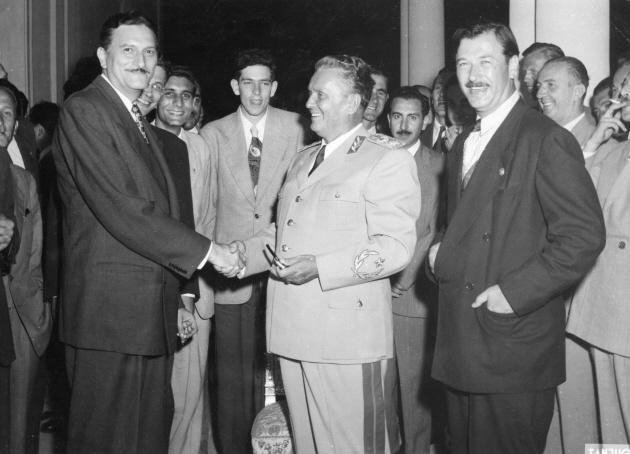
This photograph, from Jacqueline Piatigorsky’s archives, has been sent to us by John Donaldson (Berkeley, CA, USA), who adds:
‘I have been able to identify I.A. Horowitz, George Shainswit (partly hidden), Larry Evans, George Kramer and Herman Steiner.’
8053. Zeist
Wijnand Engelkes (Zeist, the Netherlands) reports that the Hotel Figi in his home town has a webpage showing signatures of famous guests and that the top left-hand corner includes the names G. Piatigorsky, M. Euwe and A. Alekhine.
Our correspondent notes that the hotel was the venue for the nineteenth game in the 1935 world championship match, and below we give the score from page 322 of the December 1935 Tijdschrift van den Koninklijken Nederlandschen Schaakbond:
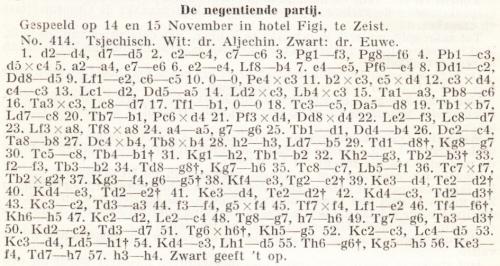
8054. Alekhine’s French citizenship
A search in Google Books, or on the Internet more generally, throws up all kinds of claims as to when Alekhine became French. For example, from page 234 of the New Encyclopaedia Britannica (various editions) and the Universalium website:
‘After the Russian Revolution of 1917, Alekhine became a naturalized French citizen ...’
On the other hand, the introduction to a Keres v Alekhine game in the various editions of L’art de faire mat by Georges Renaud and Victor Kahn – both of whom knew Alekhine well – stated ‘naturalisé français en 1929’.
The year 1925 is often seen too, but an editorial note on page 22 of the January 1962 Europe Echecs (C.N. 8025) gave a specific date in 1927, commenting that the world title match in Buenos Aires began as a contest between a Russian and a Cuban and was won by a Frenchman:
‘Pour conclure ces souvenirs concernant Alekhine, rappelons un fait curieux: né en 1892 à Moscou, Alekhine a été naturalisé français par décret du 2 novembre 1927 alors qu’il disputait en Amérique du Sud, du 16 septembre au 30 novembre 1927, le championnat du monde qu’il remporta contre Capablanca. Si bien que le match commencé par un Russe contre un Cubain fut gagné par un Français.’
Can official documentation be found regarding Alekhine’s naturalization?
8055. Saint-Amant v Staunton
James Pelletier (Costa Mesa, CA, USA) refers to game 13 in the 1843 match in Paris between Saint-Amant and Staunton, which is commonly given in databases as follows:
1 d4 e6 2 c4 d5 3 e3 Nf6 4 Nc3 c5 5 Nf3 Nc6 6 a3 Be7 7 Bd3 O-O 8 O-O b6 9 b3 Bb7 10 cxd5 exd5 11 Bb2 cxd4 12 exd4 Bd6 13 Re1
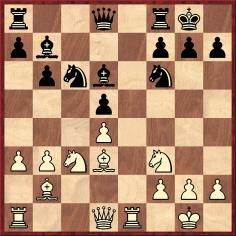
13...a6 14 Rc1 Rc8 15 Rc2 Rc7 16 Rce2 Qc8 17 h3 Nd8 18 Qd2 b5 19 b4 Ne6 20 Bf5 Ne4 21 Nxe4 dxe4 22 d5 exf3 23 Rxe6 Qd8 24 Bf6 gxf6 25 Rxd6 Kg7 26 Rxd8 Rxd8 27 Be4 fxg2 28 Qf4 Rc4 29 Qg4+ Kf8 30 Qh5 Ke7 31 d6+ Kxd6 32 Bxb7 Kc7 33 Bxa6 Rc3 34 Qxb5 Resigns.
However, on pages 65-67 of the Chess Player’s Chronicle, 1844 (volume five) and on pages 350-351 of Staunton’s book The Chess-Player’s Companion (London, 1849) the score was given as 13...h6 14 Rc1 Rc8 15 Rc2 Rc7 16 Rce2 Qc8 17 h3 Nd8 18 Qd2 a6. That would allow Saint-Amant to play Nb5 on or before move 18, and Mr Pelletier therefore wonders whether the actual move-order was 13...a6 and 18...h6.
We recall that the matter was discussed in the BCM after publication of Championship Chess by P.W. Sergeant (London, 1938). Below is page 205 of the May 1938 BCM:
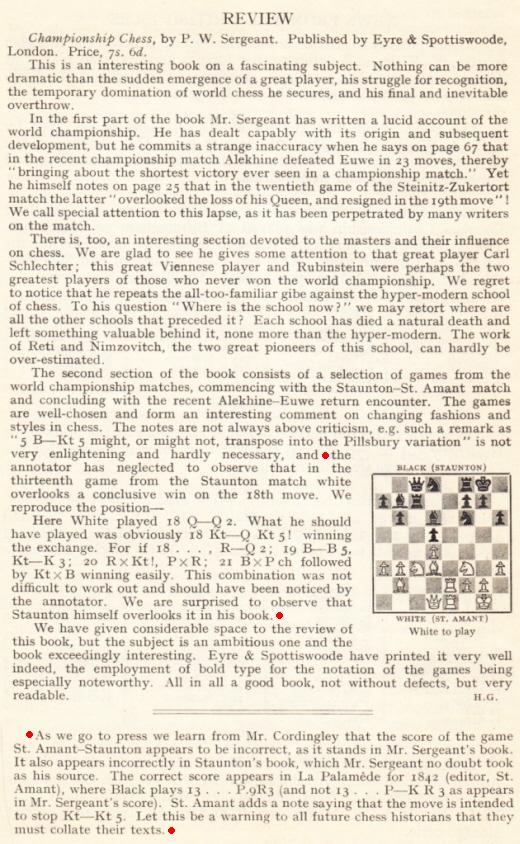
A response to Golombek’s review from G.H. Diggle was published on page 405 of the September 1938 BCM:
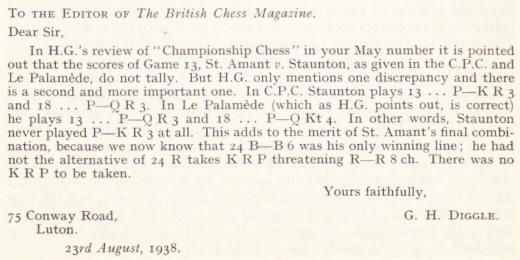
We reproduce below the score as given on pages 23-24 of the January 1844 issue of Le Palamède:

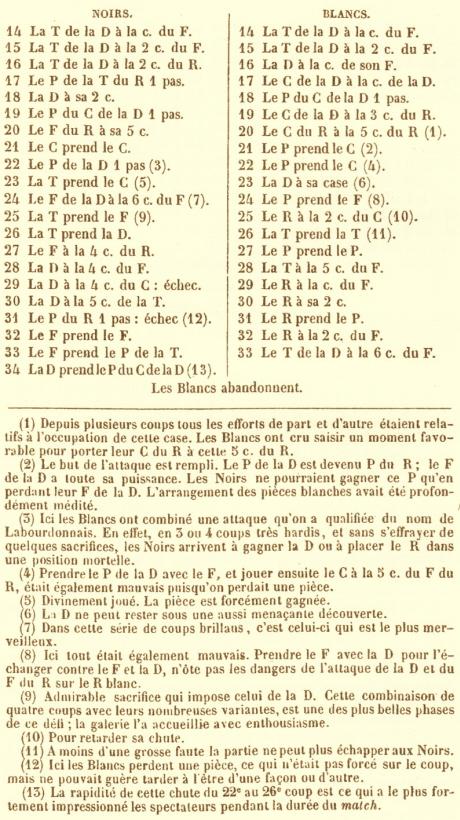
In short, there is every reason to believe that the game-score in Le Palamède is correct. If ...h6 had occurred at some point and ...b5 had not been played, Saint-Amant would have had 33 Qxf7+ instead of 33 Bxa6, since the rook on c4 would be en prise.
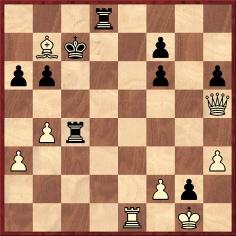
8056. Signatures (C.N. 8028)
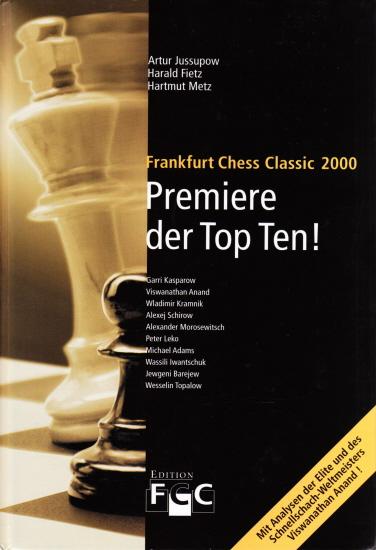
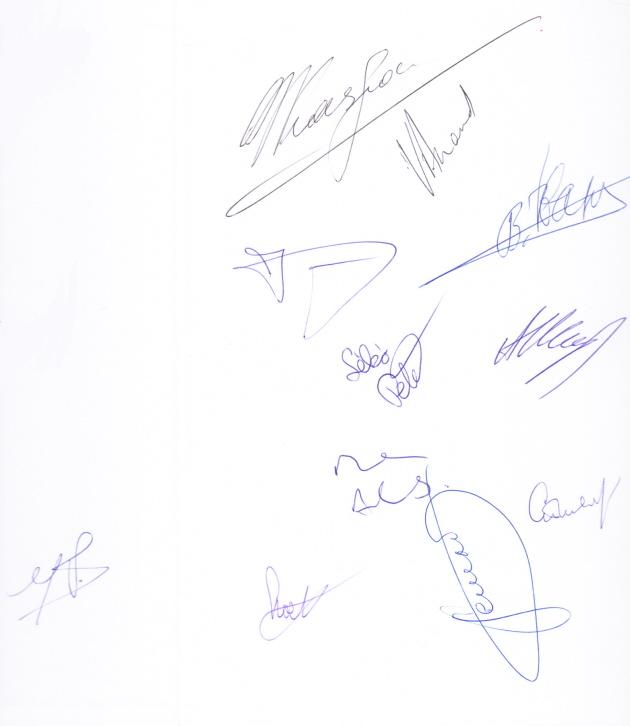
Our copy of Frankfurt Chess Classic 2000 by A. Jussupow, H. Fietz and H. Metz (Bad Soden, 2000) was inscribed by players at the 2001 Corus tournament. From the top: Kasparov, Anand, Ivanchuk, Timman, Lékó, Shirov, Adams, Topalov, Tiviakov, Piket and van Wely. Acknowledgement for assistance with identification: Rudy Bloemhard (Apeldoorn, the Netherlands).
On other pages the book was also signed by Gulko and Seirawan.
8057. Welsh newspapers
John Townsend (Wokingham, England) points out the website Welsh Newspapers Online and offers, by way of example, a brief item which he found on page 2 of the Aberystwyth Observer, 4 February 1888:
‘Mr Justice Wills on Tuesday tried an action brought by the widow of Mr Horwitz, a writer on chess, to recover £45 from Mr Charles Windust. Defendant, on behalf of the plaintiff, sold for £75 the copyright of a work on chess, and paid £30 to the plaintiff, contending that he had bought it for that amount, and was entitled to sell it for what he could get. His lordship gave judgment against him for £40.’
For further details of the case, see Chess in the Courts.
8058. Alekhine’s French citizenship (C.N. 8054)
Dominique Thimognier (Fondettes, France) writes that a CD-ROM on ‘Naturalisations en France entre 1900 et 1950’ records that Alekhine was naturalized on 5 November 1927, the same day as his wife (née Fabritsky, born in Odessa on 19 March 1884). The decrees were numbered 11670-27 and 11676-27 respectively.
We are also grateful to Stéphane Krebs (Cafquefou, France) for providing the same information, from the genealogie.com website.
8059. Naturalization records
From the website mentioned in the previous item Mr Krebs also notes the following entries:
‘Ossip Bernstein
Naturalisation
Numéro de décret: 3057-33
Sujet: Bernstein Ossip
Naissance: le 20 septembre 1882 à Jitomir (Russie)
Lieu de l’acte: France
Date de l’acte: le 15 mars 1933.’‘Vitaly Halberstadt
Naturalisation
Journal Officiel: Journal Officiel du 15 septembre 1957
Décret: Décret du 23 août 1957
Numéro de décret: 14275x39-75.
Article: Art. 1. Sont naturalisés Français:
Sujet: Halberstadt Vitali
Naissance: le 20 mars 1903 à Odessa (Russie)
Lieu de l’acte: France
Date de l’acte: en 1957.’‘Saveli Tartakower
Naturalisation
Numéro de décret: 8340-45
Sujet: Tartakower Saveli
Naissance: le 9 février 1887 à Rostoff sur Don (Russie)
Lieu de l’acte: France
Date de l’acte: le 13 décembre 1945.’
8060. Alekhine notebooks
Two correspondents in Paris, Christophe Bouton and Denis Teyssou, inform us that they have created a webpage concerning notebooks written by Alekhine towards the end of his life.
Future C.N. items will revert to a number of matters, but for now we invite readers to peruse the material presented so far. It is not to be missed.
8061. Sultan Khan
With regard to the alleged illiteracy of Sultan Khan, George L. Gretton (Edinburgh) suggests that the sketch reproduced in our feature article from the Berne, 1932 tournament book appears to have the master’s signature, using the Latin alphabet:
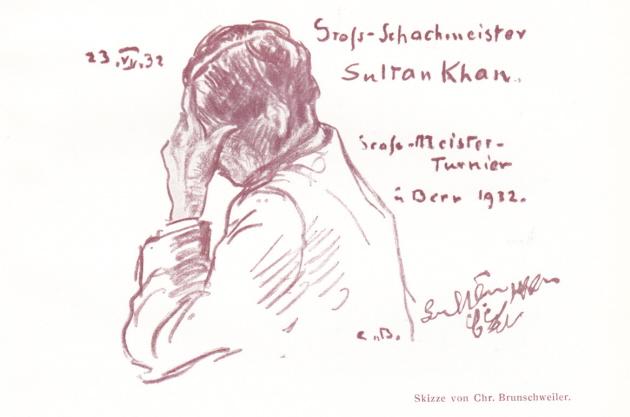
Our correspondent asks whether any other sketches in the tournament book were signed by their subjects.
The book has two further sketches, of Bernstein and Alekhine (C.N. 5054):
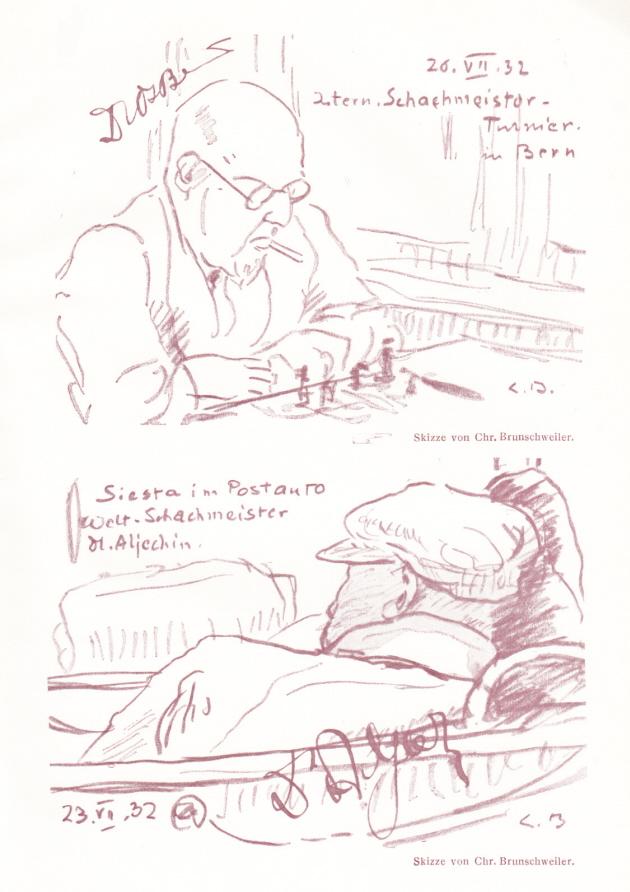
8062. Signed photograph of Ossip Bernstein
This photograph of Ossip Bernstein was the frontispiece to the monograph on him by Savielly Tartakower, Moderne Schachstrategie (Breslau, 1930):
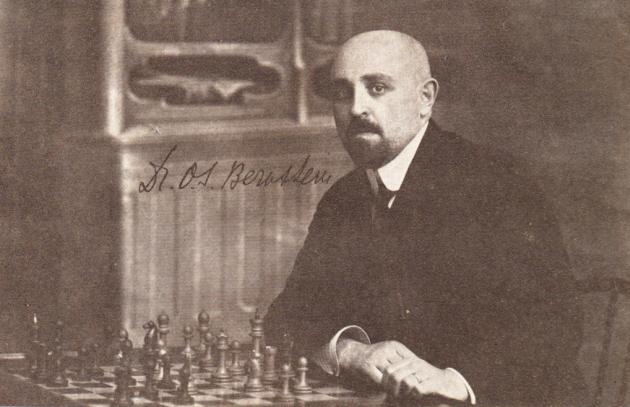
8063. Nicolai Gedalia (C.N.s 3622, 3630 & 3638)
Three victories by Nicolai Gedalia (1857-80) have been found by Eduardo Bauzá Mercére (New York, NY, USA):
Nicolai Gedalia – John Washington Baird
New York (Manhattan Chess Club Handicap Tournament), 12
February 1879
Scotch Gambit
1 e4 e5 2 Nf3 Nc6 3 d4 exd4 4 Bc4 Bc5 5 c3 Nf6 6 cxd4 Bb4+ 7 Bd2 Bxd2+ 8 Nbxd2 d5 9 exd5 Nxd5 10 Qb3 Nce7 11 O-O O-O 12 Rfe1 Nb6 13 Re2 Nxc4 14 Qxc4 Be6 15 Qb4 b6 16 Rae1 Nd5 17 Qa4 Nf4 18 Re4 Ng6 19 Ne5 Nxe5 20 Rxe5 Qd6 21 Ne4 Qd8 22 Ng5 Bd7 23 Qc2 g6 24 Qb3 Qf6 25 Qd5 Rad8 26 Ne4 Qc6 27 Qb3 Qa4 28 Qe3 f5 29 Nc3 Qc6
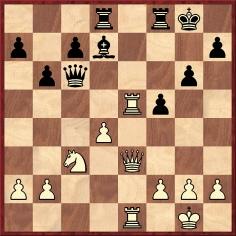
30 Re7 f4 31 Qe5 Qf6 32 Qd5+ Rf7 33 Qb3 Kg7 34 Nd5 Qf5 35 Nxc7 f3 36 Qxf7+ Qxf7 37 Rxf7+ Kxf7 38 d5 Bf5 39 Rd1 Rd7 40 d6 ‘and after several moves Black resigned’.
Source: Newark Sunday Call, 13 April 1879.
Nicolai Gedalia – Eugene Delmar
New York (Manhattan Chess Club Handicap Tournament), 28
October 1880
Queen’s Pawn Counter-Gambit
1 e4 e5 2 Nf3 d5 3 exd5 e4 4 Ne5 Qxd5 5 Nc4 Bc5 6 Nc3 Qf5 7 Qe2 Nf6 8 d3 Bb4 9 Bd2 Bxc3 10 Bxc3 Be6 11 Ne3 Qg6 12 dxe4 Nxe4 13 Qb5+ Nd7 14 Qxb7 O-O 15 Qc6 Nxc3 16 Qxc3 f5 17 O-O-O f4 18 Nc4 a5 19 f3 Nf6 20 Ne5 Qe8 21 Bc4 Kh8 22 Rhe1 Bxc4 23 Qxc4 Qh5 24 Qxf4 Nd5 25 Qd2 Nb4 26 a3 Qf5 27 axb4 axb4 28 b3 Ra2 29 Kb1 Ra3 30 Qd3 Qf6

31 Qd8 Qf5 32 Qxf8+ Qxf8 33 Rd8 Kg8 34 Rxf8+ Kxf8 35 Kb2 Ra6 36 Re4 c5 37 Nd7+ Kf7 38 Nxc5 ‘and wins’.
Source: Turf, Field and Farm, 26 November 1880, page 348.
The third game was headed:
‘Last game ever played by the late Mr Nicolai Gedalia. Played with several other off-hand games, on the evening of 12 November 1880, the night previous to his death, between himself and Wm. M. de Visser, at the Manhattan Chess Club.’
William M. de Visser – Nicolai Gedalia
New York, 12 November 1880
Ruy López
1 e4 e5 2 Nf3 Nc6 3 Bb5 a6 4 Ba4 Nf6 5 O-O b5 6 Bb3 Bd6 7 d4 exd4 8 e5 Bxe5 9 Nxe5 Nxe5 10 Re1 d6 11 f4
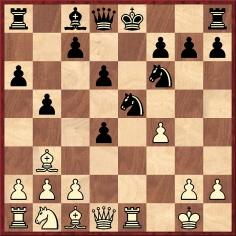
11...Ng4 12 fxe5 Qh4 13 h3 Qf2+ 14 Kh1 Bb7 15 Rg1 h5 16 Bd2 Qg3 ‘and wins’.
Source: Turf, Field and Farm, 26 November 1880, page 348.
To the report on Gedalia’s death (page 12 of the New York Times, 14 November 1880) which was quoted in C.N. 3630 Mr Bauzá Mercére adds the following from page 331 of Turf, Field and Farm, 19 November 1880:
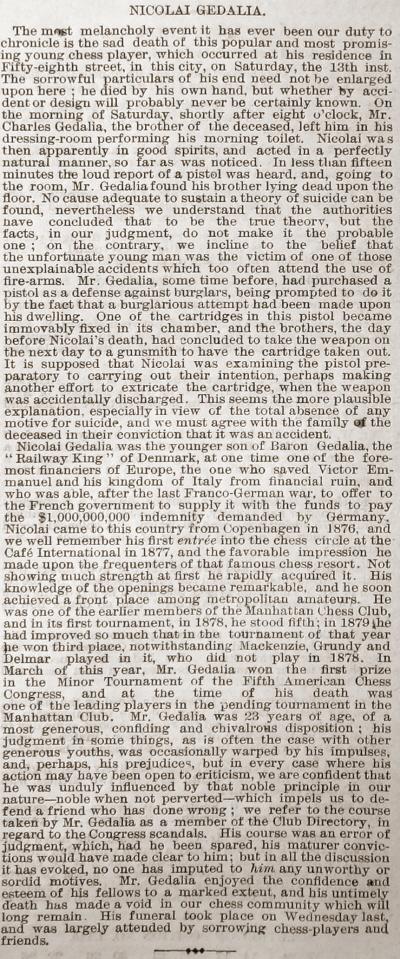
8064. Pasadena, 1932
A further photograph from Jacqueline Piatigorsky’s archives has been passed on by John Donaldson (Berkeley, CA, USA):
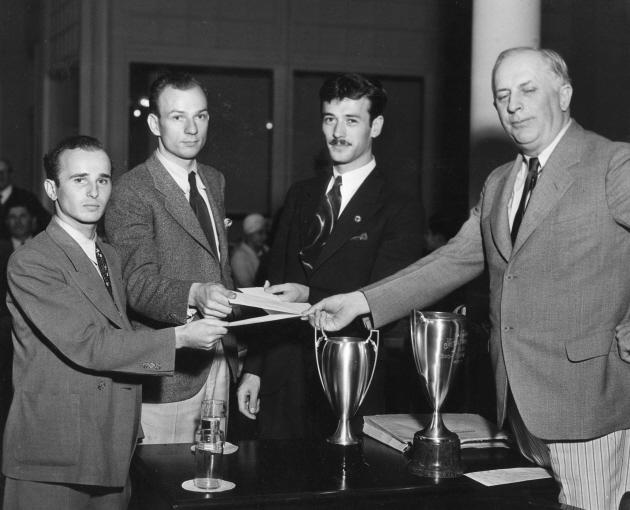
The three masters (from left to right: Reshevsky, Dake and Steiner) tied for third place. Positive identification of the fourth man will be appreciated.
8065. Sultan Khan’s signature (C.N. 8061)
Rudy Bloemhard (Apeldoorn, the Netherlands) owns a postcard (Berne, 1932) with the same signature of Sultan Khan:
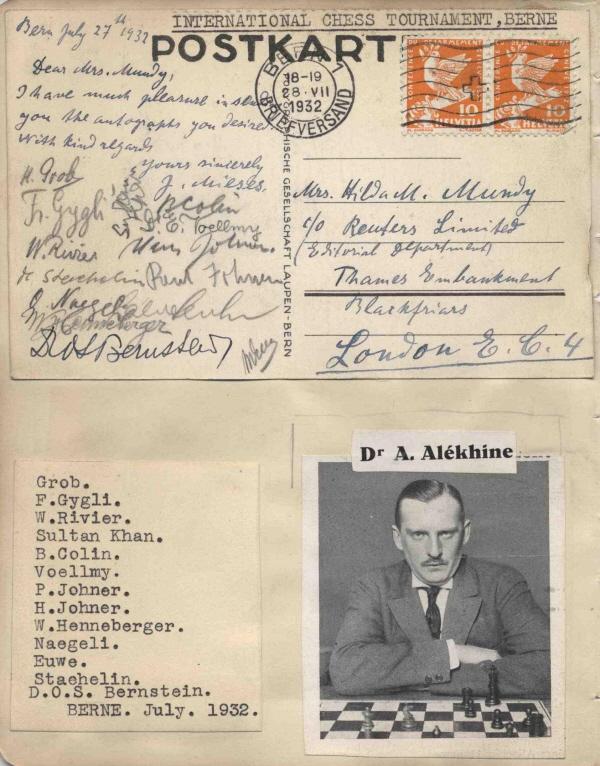
8066. Nicolai Gedalia (C.N.s 3622, 3630, 3638 & 8063)
A further game, submitted by John Hilbert (Amherst, NY, USA):
Nicolai Gedalia – ‘Mr P.’
Manhattan Chess Club, New York, 1880
(Remove White’s queen’s knight.)
1 e4 e5 2 Nf3 Nc6 3 Bc4 Nf6 4 d4 d6 5 O-O Bg4 6 c3 Be7 7 h3 Bxf3 8 Qxf3 h6 9 d5 Na5 10 Bd3 b6 11 b4 Nb7 12 Bb5+ Nd7 13 Bc6 Rb8 14 Qg4 g6 15 f4 h5 16 Qf3 a5 17 f5 g5 18 f6 Bf8 19 Bxg5 axb4 20 cxb4 Qc8 21 Qf5 Ra8
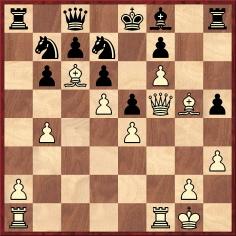
22 Qe6+ Kd8 23 Qxf7 Ra3
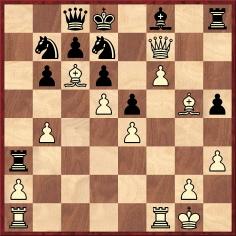
24 Qe8+ Kxe8 25 f7 mate.
Source: St Louis Globe-Democrat, 28 November 1880, which stated that the game had been played ‘a few weeks ago’.
8067. Combinations and sacrifices
As an addition to What
is a Chess Combination?, Ola Winfridsson (São Paulo,
Brazil) suggests that a particularly apt and lucid
explanation of what constitutes a combination is on pages
12-16 of volume one of Complete Chess Strategy by
L. Pachman (London, 1975), where two well-known positions
were discussed:
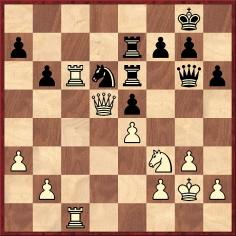
Důras v Barász, Breslau, 1912 (before 35 Rxd6)
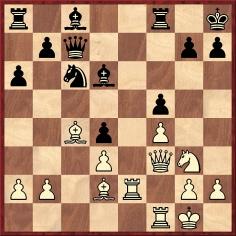
Nimzowitsch v Rubinstein,
Dresden, 1926 (before 18 Nh1)
Our correspondent remarks that Pachman makes a distinction between ‘manoeuvre’ and ‘forcing manoeuvre’ (the latter forces certain replies by the opponent), and that the book states on pages 15-16:
‘A forcing manoeuvre which is based on certain strategic contradictions is called a combination. This term is very often confused with sacrifice, but this is wrong for two reasons.
Firstly, because the strategic contradiction which is the basis of every combination does not necessarily involve the sacrifice of material. The side carrying out a manoeuvre may accept a certain positional disadvantage such as a weak pawn, the exchange of a well-placed piece, an exposed king, etc. These and similar freely accepted positional disadvantages are of course just as much strategic contradictions. During the rest of the manoeuvre the active side reaches a position which is more advantageous than the original one, and this again is the hallmark of a combination, although sacrifice does not come into it.
Secondly, there are sacrifices which are in no way connected with a manoeuvre. In our chapter “The value of the pieces” we shall demonstrate that the value of individual pieces is relative, depending upon the kind of position they are in. We shall then see “positional” or “strategic” sacrifices which are not part of a combination but arise from considerations about the effectiveness of certain pieces.’
8068. Bernard Levin (C.N. 3662)
From page 173 of All Things Considered by Bernard Levin (London, 1988) comes another (‘once’) example of how tinkering with chess can make an ‘intellectual’ writer seem anything but:
‘Fischer is not known to have done, said or thought anything at all other than about matters pertaining to chess, and once, when he gave up chess temporarily, he did nothing but play billiards for a couple of years.’
8069. The Stonewall
A remark which we jotted down at the time from Clive James’ television column in The Observer, 9 July 1978, page 23:
‘The chief characteristic of people without a sense of humour is that they will laugh at anything.’
It is a while since additions were made to the Chess Corn Corner, but the following by Roger J. Wright may be noted from page 48 of the (hors série) Christmas 1893 issue of the BCM:

Such material is likely to have generated few chuckles
even during Christmas 1893, but it prompts a question
about the Stonewall Opening: when did that term first
appear in chess literature? Suggestions from readers will
be welcomed.
An early occurrence was on page 340 of the October 1882 BCM, where C.E. Ranken was annotating the game Ware v Weiss, Vienna, 1882. After 1 d4 d5 2 f4 he wrote:
‘This is what Mr Ware has named his “Stonewall Opening”, and he certainly exhibits great skill in the management of it in this game; it is, however, contrary to the principles, and ought to beget an inferior position, though doubtless it is preferable to his former eccentricity 1 P to QR4, which he practised in the last American Congress.’
8070. Guynebans
From Bob Jones (Exmouth, England):
‘The 44 problem books of Alain C. White which became known as the “Christmas Series” were listed by D.J. Morgan on pages 49-53 of the Chess Reader, Winter 1955-56 and on pages 10-12 of the Spring 1956 issue. The Series finished in 1936, following the death of White’s “curator”, George Hume, and White did not pick up the reins again until 1941, after he had formed a relationship with Frank Altschul.
Altschul’s private passion was publishing, and he created the Overbrook Press. Eight chess problem books were published between 1941 and 1945, and these were described in a further list on pages 13-15 of the Spring 1956 Chess Reader, under the nom de plume “Guynebans” . The descriptions of these eight books are much more detailed than those in Morgan’s list, and include information about the type of paper used and from whom it was purchased; such inside knowledge was presumably available only to Altschul. In 1997 the editor of the Chess Reader, K. Whyld, published the two lists in booklet form (66 copies).
I am aware that Guynebans was a semi-mythological aristocrat in early mediaeval British history, but who adopted “Guynebans” as a pseudonym when presenting the second list of White’s books?’
Below is A.C. White’s inscription in our copy of a volume in his Christmas series, An English Bohemian: A Tribute to B.G. Laws by J. Keeble (Stroud, 1933):
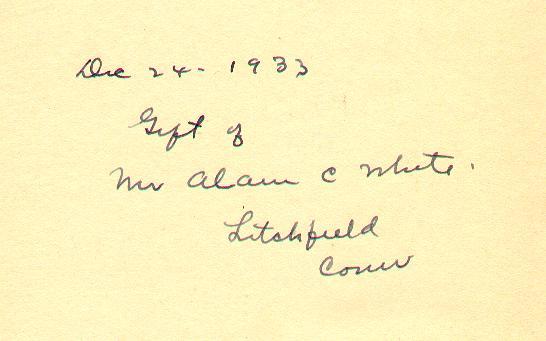
8071. US Presidents (C.N. 7977)
From Robert John McCrary (Columbia, SC, USA):
‘Page 533 of Fiske’s volume on New York, 1857 refers to the 1833 book Travels in the United States of America and Canada by I. Finch:
‘This same chess-loving Mr Finch, when at Monticello, could not avoid introducing the subject of his favorite pastime into his conversations with Jefferson. The celebrated ex-President distinctly tells him: “I played with Dr Franklin at chess, and was equal to him at the game.”’
Unfortunately, this quote does not say when the conversation occurred. Thomas Jefferson died on 4 July 1826.’
8072. Appearance
Thomas Höpfl (Halle, Germany) notes a report on page 3 of the 31 August 1866 edition of Die Debatte und Wiener Lloyd (left-hand column):
‘The Club took offence at Steinitz’s not very agreeable appearance and, not finding him suitable to represent the Wiener Schachklub, refrained from sending anyone to the London Chess Congress.’
The newspaper added that Steinitz went to London under his own steam.
8073. Fake photograph
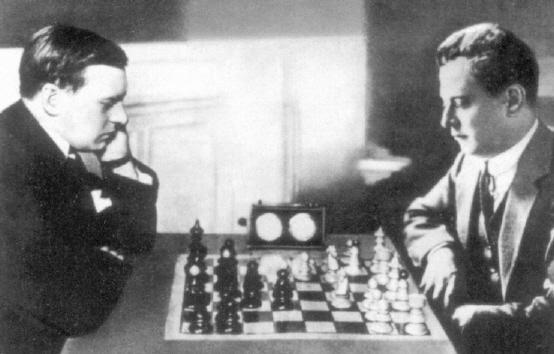
The fake photograph of Alekhine and Capablanca continues to be disseminated unquestioningly. It was on prominent display at the 2013 Alekhine Memorial Tournament and is on page 250 of Alekhine’s My Best Games of Chess 1908-1937 (Milford, 2013).
8074. Alekhine’s wedding in 1934
Denis Teyssou (Paris) points out that the registration record of Alekhine’s last marriage (26 March 1934) is available on line at the website of the Conseil général des Alpes-Maritimes (page 4):
‘Alexandre Alekhine, homme de lettres, né à Moscou (Russie) le dix-neuf octobre mil huit cent quatre-vingt-douze, quarante [et] un ans, domicilié à Villefranche-s-mer, fils majeur de Alexandre et de Agnès Prokhoroff, divorcé de Nadezda Simonovna Fabritzky depuis le dix-neuf février mil neuf cent trente-quatre.’
‘Grâce Wishaar, sans profession, née à Beverly, état de New Jersey (Etats-Unis d’Amérique) le vingt-six octobre mil huit cent quatre-vingt-six, quarante-sept ans, domiciliée à Villefranche-s-mer, fille majeure de Emile Bernard et de Marie Ida Smith, divorcée de Henry James Bromley, veuve de Archibald Freeman.’
Mr Teyssou notes that Grace Wishaar’s year of birth was given as 1886, rather than 1876. See page 254 of Chess Facts and Fables and C.N. 7565.
8075. On and on
An article by G.H. Diggle in the May 1985 Newsflash and reprinted on page 21 of volume two of Chess Characters (Geneva, 1987):
‘The autopsy on the late world championship contest continues. An eminent “ex-Soviet” grandmaster has now declared categorically that “the infamous match ended, appropriately, in shame”. To which “the two Ks” may well reply, in the famous words of a lady witness who made court-room history, “He would, wouldn’t he?”
But throughout the ages, long chess matches have always “come in for some stick”. Löwenthal and Williams, 1851 (L. 7, W. 5, drawn 4) lasted only 16 games but, with no time-limit and Williams at the board, occupied nearly two months. Staunton (annotating the eighth game) maintains an ominous silence for the first 20 moves, but finally erupts:
“It can hardly fail to strike the most unobservant reader that in this match there is scarcely any combination on either side. Mr Williams, with his habitual imperturbability, contents himself by keeping his game together, and exchanging his pieces as opportunity serves, satisfied to await the chances which a 12 or 14 hours’ sitting may turn up. The Hungarian, in despair of infusing anything like fire into such an unimaginative opposite, resigns himself to the far niente tactics of the enemy, and like him resolves to wait and watch also. The remarkable thing is that with all this wariness and lack of enterprise, with hours upon hours devoted to the consideration of the shallowest conceptions, the games abound with blunders. In a game shortly preceding this one, Mr W. leaves a bishop en prise. In the present, we find Mr L. very generously giving up his queen, and in the very next game Mr W. loses his queen in a similar manner.” [London, 1851 tournament book, page 277.]
Some shorter matches have fared little better. When Steinitz beat Blackburne in 1876 (7-0-0) the crestfallen anti-Steinitz Westminster Papers summed up as follows (it should first be explained that the arrangement was for each game to be adjourned after four hours, play to be resumed “after dinner”, and further that the rooms of the West End Club were commandeered for the match against the wishes of some of the members):
“... The professional chessplayers’ mountain has brought forth its mouse. The match, which one of the players has described as ‘momentous’, will certainly be memorable, if only ... from the thoroughly mercenary manner in which the affair has been conducted throughout. At the West End Chess Club, where the players meet, an admission fee is levied upon any innocent that may be caught abroad for the purpose of witnessing a chess farce, and ... an organized Club is converted into a “Bohemian” free-and-easy, with no higher motive, that we can see, than to put a few half guineas into somebody’s pocket. A chess match conducted in such a manner could not possibly evoke much interest outside of the little knot of do-nothings, ... and the character of the play has only increased the indifference with which it is regarded by the London chessplayers. Up to the present time, six games have been played, and all have been scored by the Bohemian. ... After four hours’ play, the players will leave the roped arena, in which they sit, ‘caged as our rarer monsters are’, adjourning for dinner. Then will the long hushed voices of the gallery break forth into Babylonian noises, and after wild discussion, and still wilder analysis, the verdict will be ‘an even game’. ... Anon the players will resume play, and from that time forth, slowly, but surely, the Englishman’s pawns will disappear from the board, and soon the Bohemian Caesar will add another spangle to his tinsel crown. This, in little, is the story of the ‘momentous’ chess match. In every game, except the first, the English player has outplayed his adversary for four hours, but that tocsin of the soul, the dinner bell, seems to have exercised a very curious effect upon his ‘space imagination’, and if he were not a blindfold player, we should be inclined to remind him of Carrera’s observation that ‘fulness is contrary to speculation and obfuscates the sight’.”’ [Westminster Papers, 1 March 1876, page 215.]
8076. The Stonewall (C.N. 8069)
Eduardo Bauzá Mercére (New York, NY, USA) writes:
‘The first appearance of the term “Stonewall” that I have found is in G.H. Mackenzie’s column in Turf, Field and Farm, 23 January 1880, page 60, in comments on the game Ware-Cohnfeld at the Fifth American Congress (New York, 1880):
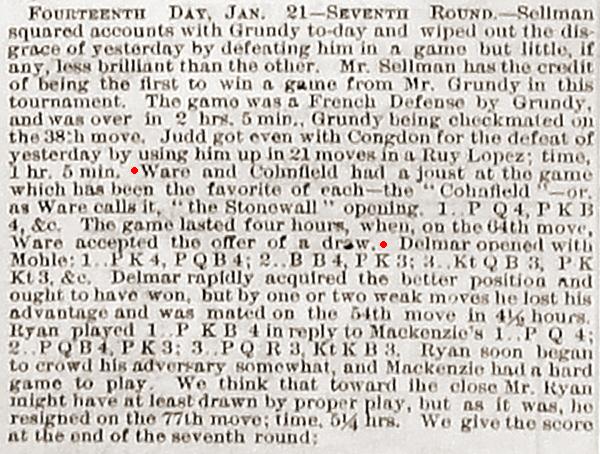
The game began 1 d4 f5 2 f4 (tournament book, pages 331-333).
8077. Hammond v N.N.
Also from Turf, Field and Farm (13 February 1880, page 107) Mr Bauzá Mercére passes on this miniature won by George Hammond:

(Remove White’s queen’s rook) 1 e4 e5 2 f4 exf4 3 Nf3 g5 4 Bc4 Bg7 5 c3 Nc6 6 Qb3 Qe7 7 O-O Na5 8 Qb5 Nxc4 9 Qxc4 d6 10 d4 Bd7 11 Qxc7 Bc6 12 Qa5 g4 13 Ne1 Bxe4 14 Nd2 Bxg2 15 Nxg2 f3 16 Re1 Be5 17 dxe5 fxg2 18 Ne4 dxe5 19 Bg5 Qe6 20 Nf6+ Kf8 21 Rxe5 Qb6+ 22 Qxb6 axb6
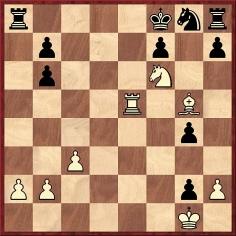
8078. Grace Wishaar
Christian Sánchez (Rosario, Argentina) notes an early mention of Alekhine’s future wife, including a reference to her chess, on page 6 of the San Francisco Call, 13 October 1904:
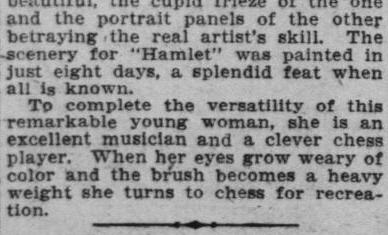
8079. Copying
Further material has been added to our Copying feature article.
| First column | << previous | Archives [106] | next >> | Current column |
Copyright: Edward Winter. All rights reserved.